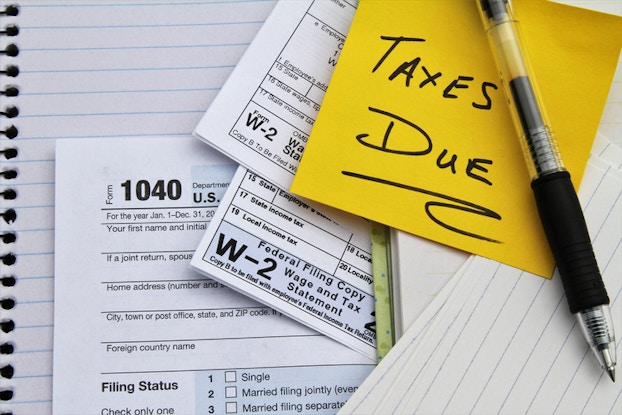How W2 Employees Are Taxed Differently Than 1099 Contractors


From ride-hailing apps to the rise of mobile delivery services, many self-employed Americans have turned to the gig economy in the past decade to pursue a career, with 36% of employed individuals classifying themselves as independent workers — equal to about 58 million Americans. That number is likely to increase, with the number of U.S. contract employees expected to grow exponentially by 2028 to over 90 million.
As the number of independent professionals rises, it’s important to understand how your business can benefit from working with self-employed contractors and, more importantly, how to classify them to the Internal Revenue Service (IRS).
What is a 1099 worker?
Independent contractors or freelancers are also known as “1099 workers,” which comes from the tax form they file with the IRS at the end of the year. As self-employed workers, businesses are not legally required to provide freelancers with benefits or add them to their payroll since they are not technically employed by the organization. Instead, 1099 workers are generally brought onto a team for a short period to assist with a specific task or specialized project.
Many small businesses consider hiring 1099 contractors over W-2 employees to reduce costs and avoid legal responsibilities. However, there are a few big differences between a 1099 contractor and a W-2 employee.
As the gig economy grows, it’s becoming increasingly important to correctly classify your workers. Misclassifying W-2 employees as 1099 contractors is a costly mistake that can stop your business in its tracks as you may face hefty penalties, lawsuits, or even jail time.
What is the difference between W-2 and 1099 workers?
The line between a W-2 employee and a 1099 contractor may seem blurry, but the most important difference is whether your business must withhold taxes from a worker’s payments.
If you classify a worker as a W-2 employee, you are required to withhold Social Security tax, income tax, Medicare tax, and any state income taxes for the benefit of the employee. If you classify a worker as a 1099 contractor, they are responsible for paying federal and state taxes themselves.
The IRS offers the following guidance to help companies differentiate between the two types of workers and properly classify them.
In most cases, a worker should be classified as a W-2 employee if:
- You (the business owner) control the details of how the work is performed.
- You provide office space, equipment, and supplies for the worker to complete tasks.
- You provide employee benefits, such as insurance, retirement plans, or vacation time.
Workers should be classified as 1099 contractors if:
- They control when and how they perform their work.
- They use their own equipment and supplies to complete tasks.
- They provide services to several different clients who pay them directly for their work.
[Read more: 5 Perks You Can Offer 1099 Workers]
Hiring a W-2 employee vs. a 1099 worker
Understanding the difference between W-2 employees and independent contractors can not only yield financial benefits for a business but also foster its growth. Plus, it’s crucial for companies to accurately classify their workers to avoid potential legal complications.
The advantages of hiring a W-2 employee
W-2 employees are hired by a company with the intent that they will remain on the team long-term. They are required to meet the company’s standards to maintain employment, giving employers control over staff, the work they produce, and the tools they use.
The disadvantages of hiring a W-2 employee
Businesses are required to provide more resources to W-2 employees than they are freelancers, including tools, training, and onboarding, and they must cover business expenses on behalf of the employee. This can lead businesses to pay more per employee than they anticipated, ultimately becoming a drain on resources.
The advantages of hiring a 1099 worker
Independent contractors generally operate on a short-term contract, assisting companies with specialized projects before moving on to other clients. They offer businesses advanced skill sets without having to go through the entire hiring process — perfect for businesses that need temporary expert assistance at an affordable price. They also provide their own tools and don’t require extensive training, saving company resources.
As the gig economy grows, it’s becoming increasingly important to correctly classify your workers.
The disadvantages of hiring a 1099 worker
Companies have less control over when and how work is produced by independent contracts, as these workers have the right to set their own schedule and use whatever tools they wish to get the job done. For businesses that have specific work processes and procedures, utilizing a 1099 worker may lead to inadequate results for their needs.
Additionally, among other legal concerns, workers’ compensation does not protect businesses in the event a 1099 worker is hurt on the job since the business does not employ the freelancer and doesn’t provide benefits.
What are the penalties if you misclassify employees?
Across all industries, between 10% and 30% of employees — roughly several million people — are misclassified as 1099 contractors every year. Classifying employees as independent contractors means a company can avoid paying Medicare, Social Security, overtime, unemployment compensation, workers’ compensation, and various employee benefits ranging from vacation pay to retirement plans.
Employers who are caught misclassifying their workforce face hefty fines and penalties, which is why it is crucial to correctly classify your employees. These fines and penalties can include back wages, due to a failure to pay minimum wage or overtime in compliance with the Federal Fair Labor Standards Act, as well as a stop work order on your business — or even a full-on ban, prohibiting your business from operating in a state or country. Businesses could also be subject to a Form 1-9 audit by the Department of Homeland Security, U.S. Immigration and Customs Enforcement, and the Department of Labor, and they could incur additional liabilities.
The penalties for misclassifying employees vary based on whether the IRS and Department of Labor determine the error was unintentional or not. If your business makes an honest mistake and classifies a W-2 employee as a 1099 contractor, you may face the following penalties:
- $50 for every W-2 the employer failed to file correctly.
- 1.5% of wages.
- 40% of FICA taxes that were not withheld from the employee.
- 100% of the FICA taxes the employer should have paid.
- 0.5% of the unpaid tax liability for each month up to 25%, according to the Failure to Pay Taxes penalty.
If the IRS determines you intentionally misclassified employees, it can impose additional fines and penalties, such as paying 100% of both the employer and employee’s share of FICA taxes. The IRS may also charge criminal penalties of up to $1,000 per misclassified worker and impose one year in prison.
The government takes employee misclassification seriously, especially with underreported tax liabilities representing 80% of the country’s gross tax gap in the United States.
[Read more: What to Know Before Hiring Gig Workers]
Protecting your business from misclassification penalties
Misclassifying an employee impacts both the employer, who could face legal ramifications, and the worker, who loses access to an abundance of protections and benefits they are owed. Because an employer does not supplement the taxes from 1099 workers, they incur additional tax responsibilities and must pay more out of pocket. However, an unsuspecting misclassified employee may not be aware of these tax responsibilities, leading to financial surprises or inaccurately filed returns.
If you’re unsure how to classify your employees, you can file a Form SS-8 to the IRS. They will review the nature of the relationship between the employer and the employee and give you an official determination. This process can take several months to complete, but it may be worth the wait if you want to hire many workers with the same roles and responsibilities.
If you need to quickly determine your workers’ classification, consult with an employment attorney or tax professional before making your final decision. They’ll work with you to ensure your new hire is properly classified and review contracts to determine they are following local and state laws.
Remain in compliance by regularly conducting internal employee misclassification audits and drafting standardized independent contractor agreements to ensure all your gig workers are on the same page about expectations and payment details.
[Read more: What Is a 1099-K Tax Form?]
Is a W-2 or 1099 worker better for your business?
W-2 employees are beneficial to businesses that operate on specific processes and are looking to commit to an employee’s growth for an extended period. These employees are going to be more dedicated to the business long-term and will require more extensive training and resources; however, their work will be more tailored to your business needs.
For companies looking for assistance with a one-off project, enlisting a 1099 worker is a cheaper and more efficient solution than hiring another employee, as they offer a valuable and specialized skill set that many teams don’t have readily available and can be brought in on an as-needed basis.
This article was originally written by Sean Peek.
CO— aims to bring you inspiration from leading respected experts.
However, before making any business decision, you should consult a
professional who can advise you based on your individual situation.
CO—is committed to helping you start, run and grow your small business. Learn more about the benefits of small business membership in the U.S. Chamber of Commerce, here.
A message from

Tap into Mastercard’s Small Business Community
Mastercard understands that your business is unique. Get the help you need to achieve your business goals with resources from Mastercard’s small business community. Find marketing tips, ecommerce tools, digital payment solutions, cybersecurity advice, and more when you join.
Join Today

Published





